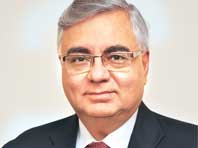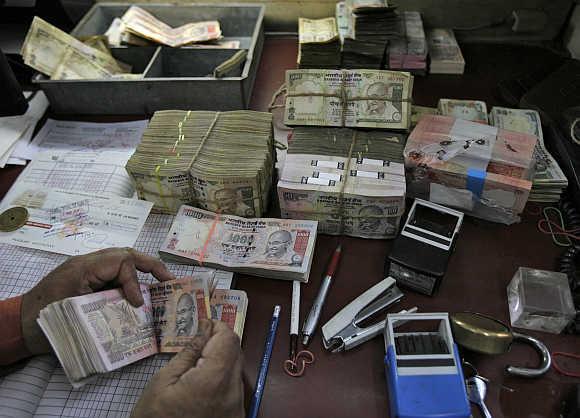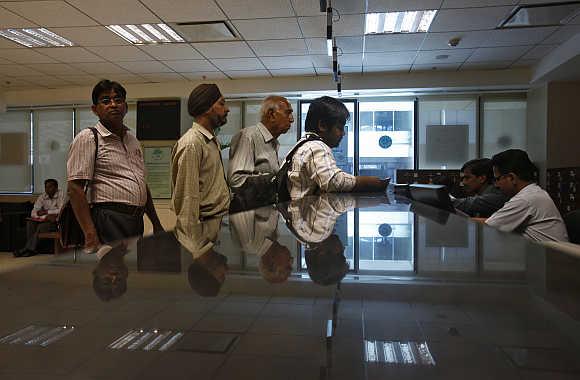 | « Back to article | Print this article |
'New govt should have balanced approach to tax administration'
The finance minister’s advisor, Parthasarathi Shome, completes his tenure at North Block next month.
But his association with the ministry is going to continue, as head of the Tax Administrative Reforms Commission (Tarc).
He tells Indivjal Dhasmana and Vrishti Beniwal in an interview that the next government’s priority should be removing tax uncertainty, while avoiding retrospective amendments. Excerpts:
 If you were to make an action plan for the next government, what would be your suggestions?
If you were to make an action plan for the next government, what would be your suggestions?
I think the primary focus has to be on tax administration. First, remove uncertainty for taxpayers. Ensure there are no retrospective amendments, like in Brazil and Sweden. Second, make tax administration accountable for its actions and decisions and ensure timeliness.
Third, accountability must be linked to minimising infructuous demands and tracking recovery. Fourth, tax evasion should be appropriately identified and followed, rather than basing your premise on taxpayers as tax evaders. Fifth, and perhaps the most important, move away from a static revenue target principle of revenue collection. Finally, regarding structural reform, of course, I hope the Direct Taxes Code (DTC) and Goods & Services Tax (GST) would be picked up. But, as I said, the first thing they should take up is a balanced approach to tax administration.
Click NEXT to read more...
'New govt should have balanced approach to tax administration'
Both the Congress and the Bharatiya Janata Party (BJP) have voiced support to GST. Do you think a consensus is possible after formation of the new government?
The intention of policymakers is clear, that they want GST. The issue is the Centre’s disagreement with some states over technical aspects, though the technical work on GST is complete.
For example, inclusion or exclusion of petroleum products. There are certain states that led the disagreement over inclusion of petroleum products in GST. But, if you keep petroleum products out, no tax policy designer could call it GST. Another issue was compensation for Central Sales Tax (CST). For how long the Centre has to give the compensation was also a point of contention. In my view, there should be quick cut-off for CST compensation.
That was not worked out fully. Flexibility to states was also given in terms of differential rates, which means states will have floor rates and can move the rates up or down. This would cause a high compliance burden on taxpayers. For the same products, he will have to deal with two different rates in two states. Interpretation of which commodities belong to which rate would also add to GST’s complications.
The concern among policymakers about compliance cost seems rather little, because the major focus seems to be on how much revenue can be obtained.
Unless we move away from an exclusive revenue objective, and towards revenue collection based on increased production of goods and services, I don’t think we are getting the concept of GST right. When GST is taken up again, I hope this fundamental concern will become the quintessential focus of the GST design, even if it requires a rethink on issues.
Click NEXT to read more...
'New govt should have balanced approach to tax administration'
BJP said GST could not be rolled out because the Centre did not address the concerns of states and the information technology infrastructure was not ready. Do you agree?
I wouldn’t like to isolate particular groups. You cannot agree with every point states make, for two reasons. One, states’ views keep changing.
Two, if you agree with all the changing views, you are not getting to GST. Yes, you may have to make some modifications to accommodate political realities or even for field conveniences, but you can’t move too far away from the crux of GST.
On IT preparedness, I agree, but I don’t think the Centre is to blame for that. For example, the Centre has its own IT framework for the Central GST.
The other part it can play is a clearing house role for inter-state trade. These can be done easily. It’s states where IT-preparedness varies a lot; so, as a whole, they have to pick up.
Click NEXT to read more...
'New govt should have balanced approach to tax administration'
Do you think it was a good idea to propose the super-rich tax — 35 per cent tax on those earning over Rs 10 crore ( Rs 100 million) a year — in the revised DTC draft?
At the level of above Rs 10 crore ( Rs 100 million), you look at the UK, Germany, Chile, China, South Africa... the rates are even higher, between 40 per cent and 50 per cent. So, raising it to 35 per cent in India is not high. The US has 35 per cent. An Indian consumer commands much more at Rs 10 crore (Rs 100 million) in terms of purchasing-power parity.
I think it was justified and essential, given our overall economic status and income distribution and where the government is spending huge amounts to reach out to the poor.
Click NEXT to read more...
'New govt should have balanced approach to tax administration'
The Vodafone case has seen too many twists and turns. What could be a possible solution to the row?
Retrospective amendments can be made for correcting errors or for making clarifications in favour of taxpayers.
In any event, you can’t have retrospective amendments to specifically counter the Supreme Court rulings. If the government insists on retroactivity in certain cases at the moment, there should not be application of interest or penalty.
The committee’s draft report was given, a final report followed but the final report is not yet on the net. The department has not come out with any position. Its acceptance would have reassured investors. If you make international comparisons, the number of disputes that we have in India far exceeds other countries.
That shows policies simply need an in-depth revisit and rationalisation. Investors view all this, and they become ever cautious about investing in India.
Click NEXT to read more...
'New govt should have balanced approach to tax administration'
Many accuse the finance ministry of scaring away investors. Do you think by reviewing the General Anti-Avoidance Rules (GAAR) and other initiatives, the ministry has removed that perception?
Here I speak as chairman of the committee to review GAAR. The introduction of GAAR was not questioned; it was the way components of GAAR were formulated in the Budget of 2012 was in question. It was rather extreme in terms of prevailing global practices. So, the committee examined it and made it rational and more applicable.
The reaction was good. But I don’t think it is sufficient to expect a change in approach overnight. The fact that a tax administration, nascent in the field application of GAAR, did not recognise the dozens of examples the committee provided in its report — where GAAR should, or should not, be applied — is deeply revealing to me on the approach being adopted by them.
I keep hoping that new generations will bravely alter that stance for their own benefit. To continue, whether GAAR is implemented with revenue in mind, or with anti-avoidance as the goal, whether officers are sufficiently trained to use this kind of instrument or not — all of these will have to be experienced.
That would eventually prove how investors take the GAAR matter with respect to their decision to invest in India. The continuing variations in the application of transfer pricing with a revenue objective is sufficient evidence of my apprehension, but I remain hopeful things will change.
Click NEXT to read more
'New govt should have balanced approach to tax administration'
Have you given a thought what would you do after your term in the finance ministry expires?
The work of Tarc is supposed to continue for another year. Beyond that, my plans are set. I have to complete three books I have agreed to.
I have to bring out the pictures I have taken for decades across the globe. I have to read the collection of my books and listen to my music, each selected over the years with care.
I want to learn Sanskrit. I want to travel to the nook and corner of the world I have missed but, importantly, to discover India in her deep recesses.
Click NEXT to read more...
'New govt should have balanced approach to tax administration'
How do you look at your two stints at the finance ministry?
It has been an excellent, challenging and chastening experience. In the first stint, I was operating on the basis of my earlier experience in India, as well as in several emerging economies. After the first stint, I was in the UK for three years, which is an advanced tax administration. So, during my first term,
I could bring in emerging-country experiences wherever they were relevant. For example, regarding annual information returns (AIR), Brazil uses information from 40 third-party sources.
We introduced six. We could use other country experiences for fringe benefits tax or bank cash transaction tax, too. We could take out the surcharge for smaller firms, since we found corporate tax incidence was very downward sloping, or, tax burden went down as a firm’s size increased. Or, we introduced calculation of revenue foregone due to tax incentives in the Union Budget. These were straightforward exercises in the first stint.
Then, I went to the UK. That experience gave me the realisation of how to trust taxpayers. That would need a sea change in the thinking here, and continues to challenge and chasten my efforts. I saw what happened in the context of GAAR and retrospective amendments to I-T rules. I became more convinced that we had to give a partnership role to our taxpayer stakeholders.
In the UK, they don’t use the term taxpayer any more. It is customers for individuals, and stakeholders for businesses. I thought we should experiment with that approach. Some people doubt whether it will work in India, but I think it will certainly work here if administration takes the first step forward.
The first term, I worked hard on DTC 2009 and GST. In the second, I worked very hard on DTC 2013. I found it was a very different tax code from 2009. The one I had worked on in 2007, whose modified form came out as 2009, had completely changed. Working on the new 2013 version was very challenging.
In my assessment, DTC 2009 comprised a deeply fundamental tax reform. DTC 2010 returned close to the current I-T Act, but had been already commented on by the Parliamentary standing committee on finance. First, I had to digest the fact that we had retreated so much between the 2009 and the 2010 versions. But we did the best to improve DTC 2010 and achieved DTC 2013.
On GST, I had worked from the VAT and wrote, with the EC (VAT), the first GST report at the end of 2007. I thought states accepted it by and large.
When I returned from the UK, I found GST was being deconstructed. Currently there does exist a draft Constitutional amendment, but big breaches in Centre-state relations remain. These have to be bridged if we are to have a globally recognised GST. And, the design certainly needs to be revisited if we want a GST with low compliance cost. So, the challenges have not ended.








